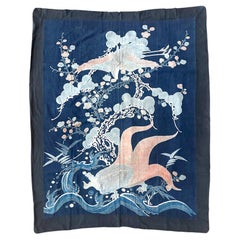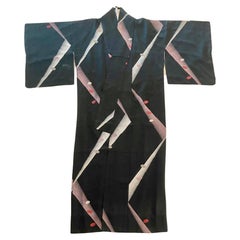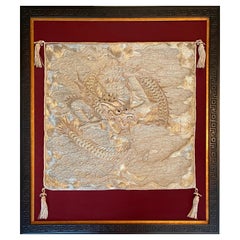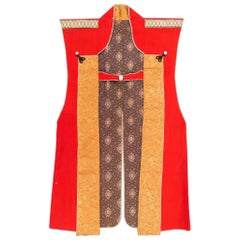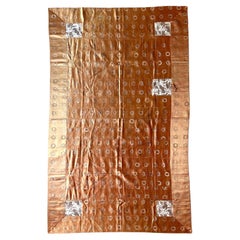Japanese Tapestries
to
3
79
5
90
Height
to
Width
to
1
1
2
38
50
32
14
1
1
86
49
33
22
12
13,984
2,181
1,390
1,239
531
90
90
90
Place of Origin: Japanese
Antique Large Japanese Futon Cover with Resist Yuzen Dye
Located in Atlanta, GA
A large unframed Japanese Futonji textile art circa late 19th century toward the end of the Meiji period. Seamed together from four vertical sections of cotton in deep indigo color, ...
Category
1890s Meiji Antique Japanese Tapestries
Materials
Cotton
Vintage Japanese Silk Meisen Kimono with Geometrical Design
Located in Atlanta, GA
A vintage Japanese formal silk Kimono in an "ink green" color with striking geometrical design. The garment is hand-stitched Meisen kimono from a crepe l...
Category
Mid-20th Century Japonisme Japanese Tapestries
Materials
Silk
Framed Antique Japanese Silk Embroidery Fukusa Textile Panel
Located in Atlanta, GA
A Japanese Fukusa Panel with tassels displayed in a gilt frame circa Meiji Period. Fukusa is a traditional Japanese textile art used as a...
Category
Late 19th Century Meiji Antique Japanese Tapestries
Materials
Silk, Wood
Japanese Fukusa Relief Embroidery Textile Art of Dragon
Located in Atlanta, GA
A visually stunning Japanese fukusa panel with an embroidered dragon on a swirling cloud background, nicely displayed on a scarlet felt matt in a carve...
Category
1890s Japonisme Antique Japanese Tapestries
Materials
Silk, Wood
Antique Japanese Textile Art Campaign Jacket Jinbaori with Mon
Located in Atlanta, GA
Known as Jinabori during 16th century when warfare was common in feudal Japan, the sleeveless jacket was created to be worn outside of the armor by samurai warriors. In addition to s...
Category
19th Century Japonisme Antique Japanese Tapestries
Materials
Textile, Silk
Antique Japanese Embroidered Silk Kesa Monk's Robe Edo Period
Located in Atlanta, GA
A Japanese Kesa (Monk's Vestment) made from thirteen columns of patchworks of fine shimmering silk fabric of a salmon orange color, the shade of which changed subtly from different a...
Category
19th Century Edo Antique Japanese Tapestries
Materials
Brocade, Silk
Japanese Antique Textile Panel of American Historical Great White Fleet
Located in Atlanta, GA
Nicknamed Great White Fleet, the sailing of the United States Navy battleships around the globe from December 16, 1907 to February 22, 1909 by order of Uni...
Category
Early 1900s Japonisme Antique Japanese Tapestries
Materials
Brocade, Silk, Wood
Antique Silk Kesa Monk's Patched Robe Meiji Period
Located in Atlanta, GA
Kesa, known as "Jiasha" in Chinese and "Kasaya" in Sanskrit, is an out-layer garment worn by the ordained Buddhist monks. Bearing a basic rectangular form, it developed originally in...
Category
19th Century Meiji Antique Japanese Tapestries
Materials
Textile, Brocade
Japanese Ceremonial Brocade Jinbaori Vest Jacket
Located in Atlanta, GA
Made entirely from luxuriant woven brocade (kinran) for the exterior, this Japanese sleeveless jacket is called Jinbaori. Commonly worn by the Samurai warriors during 16th century when warfare was common in feudal Japan, this type of loose jacket, as a surcoat on top the armor, served as an extra protection, and more importantly as an identification in the battlefield with its bright colors and often Mons. In Edo period, the society was stabilized and Jinbaori gradually shifted toward a pure ceremonial function.
The jacket on offer was unusual as it was tailored entirely from the bright Chinese brocade...
Category
19th Century Meiji Antique Japanese Tapestries
Materials
Silk, Brocade
Antique Japanese Recycled Zanshiori Jacket
Located in Point Richmond, CA
Antique Japanese Recycled Zanshiori Jacket
Zanshi-ori cloth is woven from leftover cotton and silk threads, either from commercial kimono production or from home-produced recycled y...
Category
Early 20th Century Taisho Japanese Tapestries
Materials
Cotton, Silk
Set of 4 Early 20th Century Japanese Hand Painted Split Bamboo Scrolls
Located in Bedford Hills, NY
Beautiful set of 4 Japanese hand-painted bamboo scrolls, early 20th Century.
Category
Early 20th Century Hollywood Regency Japanese Tapestries
Materials
Bamboo
Japanese Brocade Noh Costume Kimono Robe Meiji Period
Located in Atlanta, GA
A Noh costume made from magnificent silk twill brocade woven with metallic gold threads circa 1930s. The robe is identified as "Atsuita", made for male actors in the Noh play. The luxuriant fabric has a deep blue background with golden interlocking hexagon pattern that resembles tortoise shells, the symbol of longevity. The motifs showcase three auspicious symbols in repetitive patterns: roundels of coiled dragon, phoenix and peony. The kimono robe...
Category
20th Century Meiji Japanese Tapestries
Materials
Brocade, Silk
Rare Antique Formal Japanese Silk Tsutsugaki Futon Cover
Located in Point Richmond, CA
Rare Antique Formal Japanese Silk Tsutsugaki Futon Cover
An exceptional example of tsutsugaki from the late Meiji period. The abstract rendering of the auspicious phoenix and paulo...
Category
Late 19th Century Meiji Antique Japanese Tapestries
Materials
Cotton, Silk
Japanese Indigo Antique Boro Futon Cover or Wall Panel
Located in Alessandria, Piemonte
Rare perfect antique collection Japanese Indigo Boro Futon cover : also to use.
The rare antique boros are now valued as pieces of art, therefore they are...
Category
Mid-20th Century Japonisme Japanese Tapestries
Materials
Cotton
Japonese Pair of Painted and Lacquered Wood Panels, Mid-19th Century
Located in Labrit, Landes
Pair of Japanese paintings done on wood panel, probably dating from the middle of the 19th century (1850-1860).
One represents a landscape ...
Category
Mid-19th Century Antique Japanese Tapestries
Materials
Stucco, Wood
Framed Antique Japanese Embroidery Fukusa Panel
Located in Atlanta, GA
A finely embroidered Japanese silk Fukusa panel presented in a beautiful silk-lined giltwood frame (newly framed and glazed), circa late 19th century of Meiji Period. Fukusa is a tra...
Category
Late 19th Century Meiji Antique Japanese Tapestries
Materials
Silk, Wood
Framed Antique Japanese Embroidery Fukusa Textile Panel
Located in Atlanta, GA
A Japanese silk Fukusa Panel housed in a gilt frame circa late 19th century of Meiji Period. Fukusa is a traditional Japanese textile art used as a wrap for presenting gifts at important occasions. On the deep blue background, the elaborate embroidery work depicts three deities of the Shichifukujin (Seven Gods of Fortune...
Category
Late 19th Century Meiji Antique Japanese Tapestries
Materials
Silk, Wood
Antique Japanese Indigo-Dyed Double Ikat Kimono
Located in Point Richmond, CA
Antique Japanese Indigo-Dyed Double Ikat Kimono
This deeply saturated indigo-dyed kimono is made of heavy-weight hand-spun cotton and precisely patter...
Category
Early 20th Century Taisho Japanese Tapestries
Materials
Cotton
Antique Japanese Stencil-Dyed Han-Juban
Located in Point Richmond, CA
Antique Japanese Stencil-Dyed Han-Juban
Han-juban are worn under kimono. This example, without its original cotton sleeves, displays a unique stencil-dyed pattern with indigo. A ve...
Category
Early 20th Century Taisho Japanese Tapestries
Materials
Cotton
Old Japanese Kimono / 1912-1945 / Wall Hanging Decoration / Tapestry
Located in Sammu-shi, Chiba
I think this is a kimono woven from the Taisho era to the early Showa era (1912-1945) in Japan.
It is a modern design.
In the Taisho era, various things were made with reference to...
Category
Early 20th Century Taisho Japanese Tapestries
Materials
Cotton
Framed Japanese Embroidery Textile Panel Rootsters
Located in Atlanta, GA
A matted and framed Japanese silk panel with elaborate embroidery circa late Meiji to Taisho period (1910-30s). On a bright background, two rooster...
Category
Early 20th Century Japonisme Japanese Tapestries
Materials
Silk, Wood
Meiji Period Japanese Indigo Double Ikat Futon Cover
Located in Point Richmond, CA
Meiji period Japanese Indigo double ikat futon cover
Japanese futon cover, a double ikat pattern in four panels depicting Kumamoto Castle with im...
Category
1890s Meiji Antique Japanese Tapestries
Materials
Cotton
Japanese Fisherman Festival Kimono with Tsutsugaki Design
Located in Atlanta, GA
A Japanese festival Kimono robe circa late 19th to early 20th century (end of Meiji Period) for fishing ritual. Made in a cotton fabric, the kimono was elaborately decorated by Tsuts...
Category
Early 20th Century Meiji Japanese Tapestries
Materials
Cotton, Linen
Vintage Japanese Indigo Folk Kamon Textile
Located in Chicago, IL
Dating to the mid-20th century, this vintage Japanese textile is a folk example of traditional stencil dyed fabric, known as katazome. Richly...
Category
Mid-20th Century Japanese Tapestries
Materials
Cotton
Magnificent Antique Japanese Woven Brocade Kesa Monk's Robe Meiji Period
Located in Atlanta, GA
A stunning Japanese Kesa (Monk's Vestment) made from thirteen columns of patchworks of shimmering woven brocades with luxuriant golden threads. Dated to late 19th century of Meiji Period, the elaborate woven motifs on this kesa feature repetitive roundels dragon and phoenix intermixed with peonies and chrysanthemum blossoms. Two shades of contrasting gold threads were used on a striking purplish-blue background, with a dark metallic thread for the outer border and a brighter thread for the main body. The brilliantly woven fabric was possibly recycled from Noh costumes...
Category
Late 19th Century Meiji Antique Japanese Tapestries
Materials
Brocade, Silk
Framed Antique Japanese Embroidery Fukusa Panel
Located in Atlanta, GA
A finely embroidered Japanese silk Fukusa panel presented in a beautiful brocade-wrapped fame. Circa late 19th century of Meiji Period, Fukusa is a traditional Japanese textile...
Category
Late 19th Century Meiji Antique Japanese Tapestries
Materials
Silk, Wood
Framed Antique Japanese Embroidery Fukusa Textile Panel
Located in Atlanta, GA
A Japanese silk Fukusa Panel housed in a gilt frame circa late 19th century of Meiji Period. Fukusa is a traditional Japanese textile art used as a wrap for presenting gifts at important occasions. On the deep blue background, the elaborate embroidery work depicts a historical scene where street vendors selling goods to a royal household or an aristocratic residence. The scene focuses on the activities at the front gate where the couriers and servants were busying carrying the goods in. A peasant with straw coat...
Category
Late 19th Century Meiji Antique Japanese Tapestries
Materials
Silk, Wood
Vintage Japanese Formal Black Silk Kimono with Pheonix Embroidery
Located in Atlanta, GA
A vintage Japanese silk Kuro Tomesode Kimono, circa 1950s-1980s. Kuro Tomesode is a dress for married woman for the most formal occasions, equivalent of the evening gowns in the west. It is overall black, decorated only with patterns of bright colors on the bottom. This kimono has three Mon family crests on the front and back shoulder. It is lined with white silk in its interior. On the front, it features exposed white stitches around neck and breast, a very subtle and elegant touch. The bottom part of the kimono is decorated with an embroidery imagery of two phoenix in flight. The lavish use of gold and polychrome threads and meticulous rendition of the birds contrast greatly with the otherwise sober black background. Pheonix is the mythical bird traditionally represents the Queen or Female Supreme in Chinese culture. Known as Hoo-oo in Japanese, Pheonix is a symbol of good fortune, power and divine wisdom and represents the sun goddess Amaterasu, the Queen of Heaven and Creation, who was believed to be the ancestor of the lines of the Japanese imperial family...
Category
Mid-20th Century Showa Japanese Tapestries
Materials
Silk
Vintage Japanese Indigo Folk Kamon Textile
Located in Chicago, IL
Dating to the mid-20th century, this vintage Japanese textile is a folk example of traditional stencil dyed fabric, known as katazome. Richly...
Category
Mid-20th Century Japanese Tapestries
Materials
Cotton
Framed Japanese Futon Cover Textile Art with Resist Yuzen Dye
Located in Atlanta, GA
A large piece of framed Japanese textile circa late 19th to early 20th century, end of Meiji period. Seamed together from four vertical sectio...
Category
Early 20th Century Meiji Japanese Tapestries
Materials
Cotton, Wood
Recently Viewed
View AllMore Ways To Browse
Celadon Lotus Vase
Cherub Casket
Chest 32 X 19 X 32
Childs Chair Rush Seat
Chinese Blue And White Foo Dogs
Chinese Bronze Wine Vessel
Chinese Cocktail Cabinet
Chinese Collar Framed
Chinese Farmer Painting
Chinese Medicine Jar
Chinese Porcelain Brush Pot
Chinese Sancai Horse
Chinese Temple Bells
Chinese Warrior Statues
Chinese White Porcelain Figurines
Chinoiserie Bombe
Chinoiserie Paper Mache
Christmas Nativity
